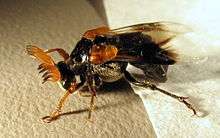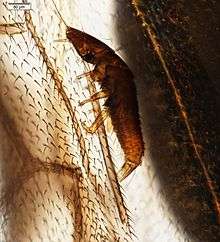Ripiphoridae
Ripiphoridae (formerly spelled Rhipiphoridae) is a cosmopolitan family of some 450 described species of beetles sometimes called "wedge-shaped beetles". Ripiphoridae are unusual among beetle families in that many species are hypermetamorphic parasitoids, an attribute that they share with the Meloidae. Members of the family differ in their choice of hosts, but most attack various species of bees or wasps, while some others attack cockroaches.
| Wedge-shaped beetles | |
|---|---|
 | |
| Ripiphorus diadasiae male. Note the characteristically small elytra and flabellate antennae | |
| Scientific classification | |
| Kingdom: | |
| Phylum: | |
| Class: | |
| Order: | |
| Suborder: | |
| Infraorder: | |
| Superfamily: | |
| Family: | Ripiphoridae Gemminger & Harold, 1870 |
| Subfamilies | |
| |

Many species of Ripiphoridae have abbreviated elytra, and flabellate or pectinate antennae. Genera include Allocinops, Rhipistena and Sharpides.[1]
Species that attack bees typically lay their eggs on flowers. There the eggs hatch almost immediately into small planidial larvae and lie in wait for a visiting host. The planidium mounts the bee and rides it back to the hive. There it dismounts and seeks a cell occupied by a host larva. The planidium then enters the body of the host. It changes its skin and shape, then remains more or less dormant until the host larva pupates. It then emerges from the bee pupa and begins to feed. It eats the entire pupa, then pupates in its turn and completes its metamorphosis before emerging from the hive to mate and lay eggs.[1][2]
Fossil species in the genera Paleoripiphorus, Macrosiagon, Cretaceoripidius, Flabellotoma, Burmitoma, Plesiotoma, and Amberocula have been described from mid- to lower-Cretaceous amber from sites in France, Germany and Myanmar.[3][4][5]
Genera
These 32 genera belong to the family Ripiphoridae:
- Alloclinops Broun, 1921 g
- Amberocula Batelka, Engel, & Prokop, 2018 g
- Ancholaemus Gerstaecker, 1855 g
- Blattivorus Chobaut, 1891 g
- Burmitoma Batelka, Engel, & Prokop, 2018 g
- Clinopalpus Batelka, 2009 g
- Clinops Gerstaecker, 1855 g
- Cretaceoripidius Falin & Engel, 2010 g
- Flabellotoma Batelka, Prokop, & Engel, 2016 g
- Geoscopus Gerstaecker, 1855 g
- Macrosiagon Hentz, 1830 i c g b
- Metoecus Dejean, 1834 g
- Micholaemus Viana, 1971 g
- Neopauroripidius Falin & Engel, 2014 g
- Neorrhipidius Viana, 1958 g
- Ohananomia Tôyama, 1986 g
- Paleoripiphorus Perrichot, Nel & Neraudeau, 2004 g
- Pauroripidius Kaupp & Nagel, 2001 g
- Pelecotoma Fischer, 1809 i c g b
- Pirhidius Besuchet, 1957 b
- Plesiotoma Batelka, Engel, & Prokop, 2018 g
- Ptilophorus Dejean, 1834 i c g b
- Quasipirhidius Zaragoza, 1992 g
- Quasirhipidius Zaragoza, 1992 g
- Rhipidocyrtus Falin & Engel, 2014 g
- Rhipistena Sharp, 1878 g
- Rhizostylops Silvestri, 1906 g
- Ripidius Thunberg, 1806 i c g
- Ripiphorus Bosc, 1791 i c g b
- Scotoscopus Reitter, 1884 g
- Trigonodera Dejean, 1834 i c g b
- Zapotecotoma Engel, Falin, & Batelka, 2019 i c g b
Data sources: i = ITIS,[6] c = Catalogue of Life,[7] g = GBIF,[8] b = Bugguide.net[9]
References
- Falin, Z.H. (2002). "102. Ripiphoridae. Gemminger and Harold 1870 (1853)". In Arnett, R.H., jr.; Thomas, M.C.; Skelley, P.E.; Frank, J.H. (eds.). American beetles. Volume 2. Polyphaga: Scarabaeoidea through Curculionoidea. Boca Raton, Florida: CRC Press LLC. pp. 431–444. doi:10.1201/9781420041231.ch6. ISBN 978-0-8493-0954-0.CS1 maint: uses editors parameter (link)
- Lawrence, J.F.; Falin, Z.H.; Ślipiński, A. (2010). "Ripiphoridae Gemminger and Harold, 1870 (Gerstaecker, 1855)". In Leschen, R.A.B.; Beutel, R.G.; Lawrence, J.F. (volume eds.) (eds.). Coleoptera, beetles. Volume 2: Morphology and systematics (Elateroidea, Bostrichiformia, Cucujiformia partim). New York: Walter de Gruyter. pp. 538–548. doi:10.1515/9783110911213.538. ISBN 978-3110190755.CS1 maint: uses editors parameter (link)
- Perrichot V.; Nel A.; Neraudeau D. (2004). "Two new wedge-shaped beetles in Albo-Cenomanian ambers of France (Coleoptera: Ripiphoridae: Ripiphorinae)" (PDF). European Journal of Entomology. 101 (4): 577–581. doi:10.14411/eje.2004.081.
- Batelka, J; François-Marie Collomb & André Nel (2006). "Macrosiagon deuvei n. sp. (Coleoptera: Ripiphoridae) from the French Eocene amber" (PDF). Ann. Soc. Entomol. Fr. 42 (1): 75–78. doi:10.1080/00379271.2006.10697451.
- Batelka, J; MS Engel & J Prokop (2018). "A remarkable diversity of parasitoid beetles (Ripiphoridae) in Cretaceous amber, with a summary of the Mesozoic record of Tenebrionoidea". Cretaceous Research. 90 (1): 296–310. doi:10.1016/j.cretres.2018.04.019.
- "Ripiphoridae Report". Integrated Taxonomic Information System. Retrieved 2018-04-22.
- "Browse Ripiphoridae". Catalogue of Life. Retrieved 2018-04-22.
- "Ripiphoridae". GBIF. Retrieved 2018-04-22.
- "Ripiphoridae Family Information". BugGuide.net. Retrieved 2018-04-22.
External links

